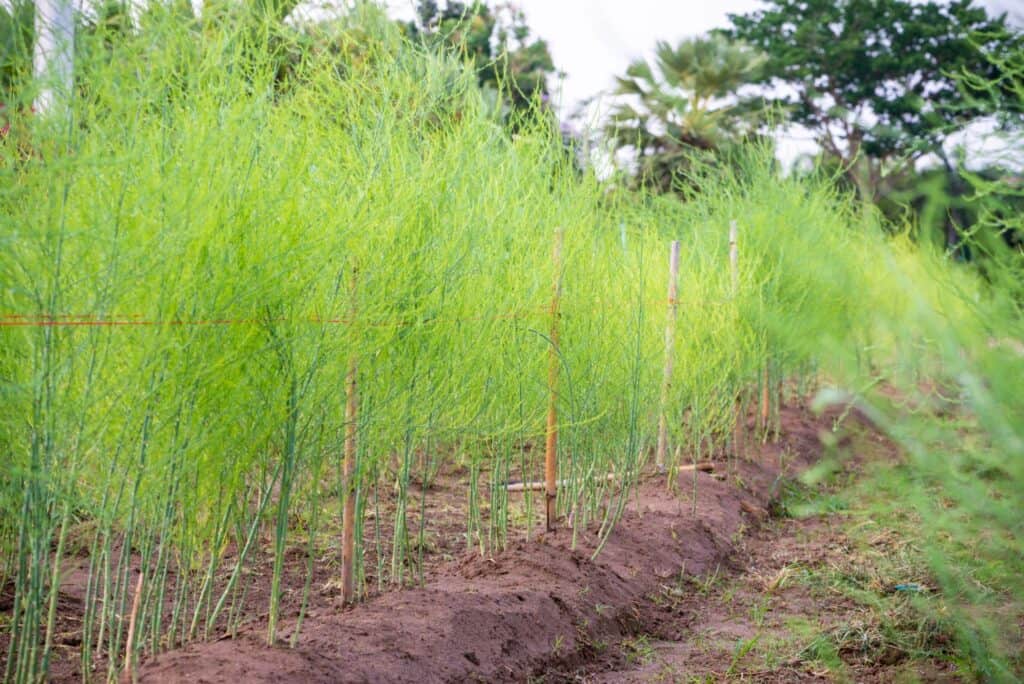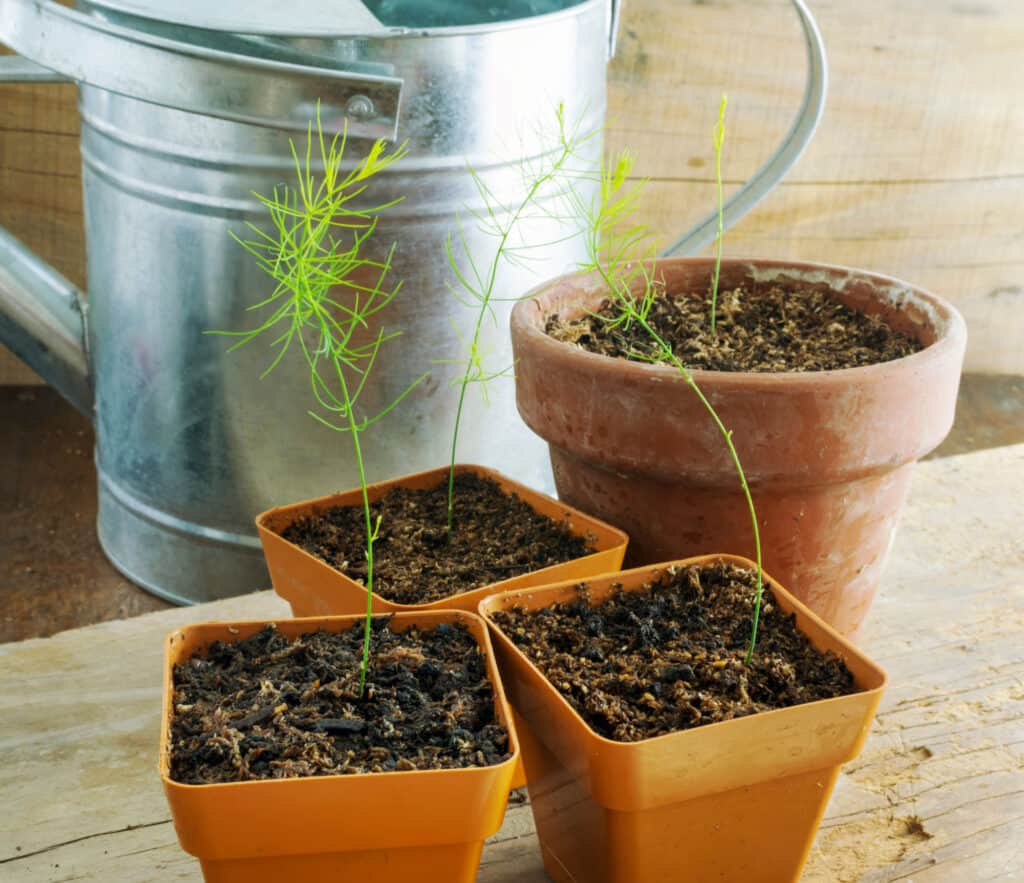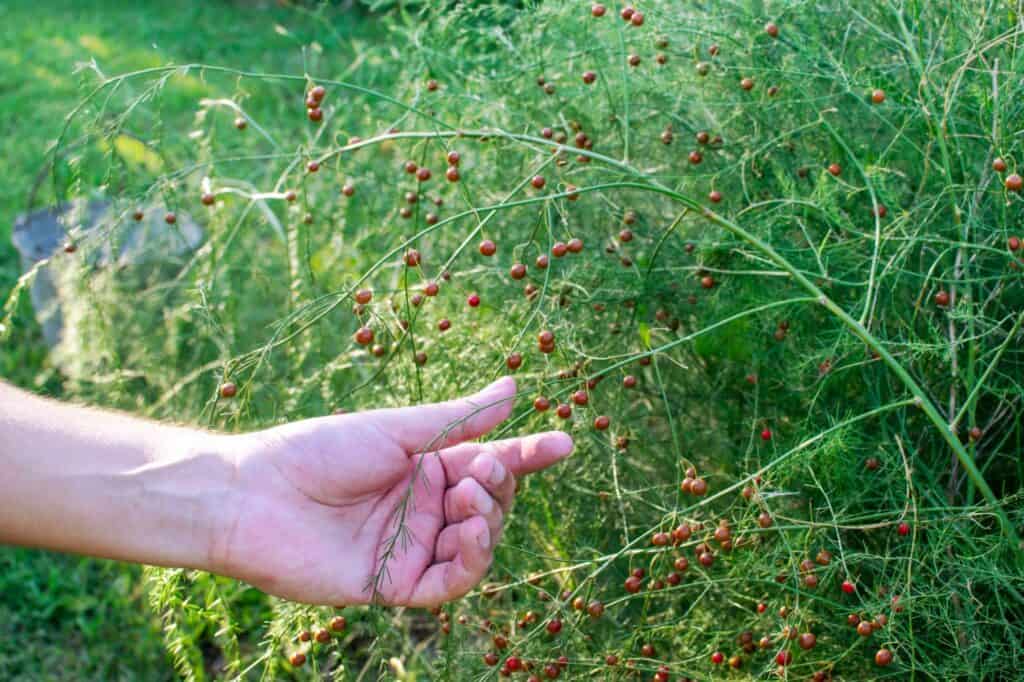There are a number of reasons why you may not have considered growing asparagus seeds. Far from quick, asparagus crops are often considered tedious and difficult to grow from seed. However, if you are patient and interested in starting your own garden, asparagus may be a fantastic vegetable to include! But what can you expect out of the process of growing asparagus from seed?
Start your asparagus seeds indoors, roughly three months before your final spring frost date. Then, move your seedlings outside, to a dedicated garden bed that gets full sun. Asparagus doesn’t transplant well and will continue to come back for decades, so choose wisely! Once planted, keep your seedlings weed-free and happy with compost and regular watering, harvesting only after your second year has come and gone.
But how else can you best take care of asparagus seedlings, and is it possible to harvest asparagus seeds from your very own crops? Let’s talk all about growing asparagus from seed now!

Start your asparagus seeds indoors, roughly three months before your final spring frost date.
©Yongkiet Jitwattanatam/Shutterstock.com
| Asparagus Seeds | How to Grow |
|---|---|
| Hardiness Zones | 4 through 9 |
| Popular Asparagus Varieties | Apollo, Jersey, Mary Washington, Purple Passion |
| Germinating Asparagus Seeds | 3 months before your final spring frost date |
| Time of Year to Plant Seeds | After your final spring frost date |
| Things to Note | Wait until your third year to harvest asparagus; this ensures your plant will thrive for many more years to come! |
Asparagus Seeds: Everything You Need to Know

When it comes to your own backyard, female asparagus plants will produce bright red seeds but fewer spears, while male plants dedicate their energy to making delicious spears and zero seeds.
©DUSAN ZIDAR/Shutterstock.com
While asparagus is easily grown from seed, there are a few important things to note about asparagus plants. There are male and female varieties of the asparagus plant, and you may have a preference for which you grow in your own garden. The primary difference? Male asparagus plants don’t produce seeds, while female asparagus plants do.
If you choose to grow asparagus from seed, there will be no control over which gender of plant you end up growing. Garden centers that sell asparagus crowns commercially always sell males, so you may have never even seen the way that asparagus plants go to seed! When it comes to your own backyard, female asparagus plants will produce bright red seeds but fewer spears, while male plants dedicate their energy to making delicious spears and zero seeds.
With all of this in mind, just know that all of the asparagus seedlings you end up growing may not remain in your garden. You may want to keep a few female plants around, should seeds be something you want regularly. However, most gardeners opt for male plants, especially when you consider the fact that asparagus is a perennial that doesn’t need replanting once established!
Germinating and Growing Asparagus from Seed

Asparagus grown from seed is much more fragile than from store-bought crowns.
©Gaston Cerliani/Shutterstock.com
Now that you know what to do once your asparagus plants have gone to seed, how can you best start these crops to begin with? Here’s our step-by-step guide to how to best plant and grow asparagus from seed:
- Start your seeds indoors, 3 months before your final spring frost date. Asparagus takes a bit of time to germinate, depending on the variety you choose. Sow your seeds roughly half an inch deep in peat pots, and keep a heat mat for them indoors!
- Germinate until your frost date has passed. Once it is safe to transplant asparagus into your ground outside, allow your seedlings a few days to harden. This allows your young plants an adjustment period before you plant them in the soil outdoors.
- Plant with care, and expect some seedlings to die. Asparagus grown from seed is much more fragile than from store-bought crowns. Plant your seedlings roughly 8 inches apart from each other, with the assumption that many young plants will perish before they are fully grown. You can always thin your crops later, should they all happen to survive!
- Weed often, and do not harvest in your first or second year. For hearty asparagus crops that return season after season, your best bet is to leave your new asparagus plants alone. While this may feel disheartening, harvesting asparagus in your first or second season won’t leave you with enough strong plants to continue on. There are certain varieties that are ready by their second season of growth, but your first year is all about establishing these crops fully!
Harvesting Asparagus Seeds

Once your asparagus berries have turned bright red, it’s time to harvest.
©Gaston Cerliani/Shutterstock.com
Let’s say you’ve allowed your asparagus crops to mature. Excellent news! But what do you do with your female asparagus crops that are producing more seeds than stalks? While female asparagus plants do still produce delicious stems, male plants produce far more stalks on average. If you find that your asparagus plants have gone to seed, here’s how to best harvest them:
- Decide whether you want to keep your female asparagus plant. Given the fact that female asparagus puts more energy into producing seeds, you may not want to keep these plants around. This is especially true when you realize just how many seeds you can harvest from a single asparagus plant; there’s no need to gather such an abundance of seeds, year after year!
- Remove the entire plant, or simply cut the flowering stalks. Once your asparagus berries have turned bright red, it’s time to harvest. You can choose to remove the entire female plant, or simply trim the tops of your asparagus, keeping the stalks and berries in a large bag.
- Leave the seeds out to dry. You’ll need nearly a month of drying time before your seeds are ready to plant. Let the berries dry on the plant, then crack open the red seed pods. The inner seeds need to dry for an additional amount of time before they can be safely stored in an envelope or jar.
While it may take time and love, establishing asparagus plants from seed can be incredibly rewarding. You can enjoy these tasty spears for generations to come with proper care!
Up Next
- Rhubarb Seeds: How to Grow, Harvest, and Care for Delicious Stalks
- Kale Seeds: How to Grow and Harvest This Leafy Green
- White Asparagus vs. Green Asparagus: What Are Their Differences?
- What to Plant in October: The Complete Guide
The photo featured at the top of this post is © Gaston Cerliani/Shutterstock.com
Sources
- Sex-biased gene expression in dioecious garden asparagus (Asparagus officinalis), Available here: https://nph.onlinelibrary.wiley.com/doi/full/10.1111/nph.13389
- Germination and vigour of primed asparagus seeds, Available here: https://www.scielo.br/j/sa/a/Gm3bfKKFyyyHSycMpMqz97s/abstract/?lang=en
Thank you for reading! Have some feedback for us? Contact the AZ Animals editorial team.






